Alaska Fish & Wildlife News
October 2015
Cutting Edge Science on the Seafloor
Testing Biocides on Invasives in Marine Waters
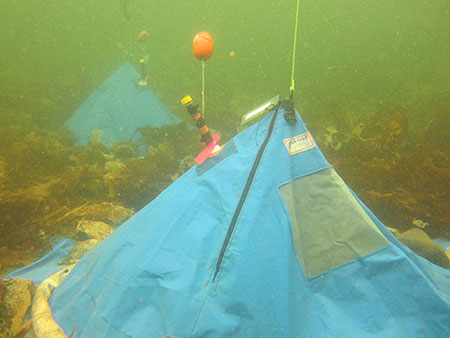
No one would be surprised to find a tent pitched by campers in the high alpine or the boreal forests or even along the rocky shorelines of Alaska, but why are there tents on the seafloor?
This summer the Alaska Department of Fish and Game (ADF&G) partnered with the Smithsonian Environmental Research Center Marine Invasions Lab (SERC) and other entities to essentially pitch tents in the subtidal waters of Whiting Harbor, near Sitka. Obviously no one was camping out down there; instead these tents or domes created a contained area within marine waters where we could study the effects of biocide agents on the invasive colonial tunicate, Didemnum vexillum (D. vexillum). Our objective was to set up the domes over a span of the seafloor infested with the invasive tunicate and then introduce various biocides to test the efficacy with which they caused mortality to D. vexillum.
Marine invaders, like invasive species in terrestrial or freshwater habitats, alter the way ecosystems function. Plants and animals not native to Alaska’s coastal environments are considered invasive if they pose a threat to the environments in which they are introduced or to economies that might be detrimentally impacted by their presence. Colonial tunicates, also known as sea squirts, can cover the sea bed like a carpet, growing over and completely covering rocks, aquatic plants, algae and small organisms that live in the crevices of boulders and under rocks along the seafloor. When sheathed beneath the tunicate colony these benthic (sea-bottom dwelling) organisms are unavailable to larger predators that rely on them for food. In Whiting Harbor, shellfish have been observed encased by the tunicate, making it impossible for mussels, clams or oysters to open up and feed. Invasive colonial tunicates are a notorious problem at aquatic farms.
Colonial tunicates, such as D. vexillum, have been introduced to coastal ecosystems around the world, including the west coast of North America, with a few locations in southeast Alaska. In some areas of the Lower 48 and British Columbia the infestations are so expansive it is too late to consider eradicating them. Even though eliminating infestations when they are small requires fewer resources, the added challenge is there are relatively few examples of managers successfully getting rid of tunicates from marine environments. Nevertheless, since the infestation of D. vexillum within Whiting Harbor, near Sitka, is the only one in Alaska there is considerable interest in determining the feasibility of eradicating it so that it can’t spread to other areas of Sitka Sound or coastal Alaska. This is where the tents come in.
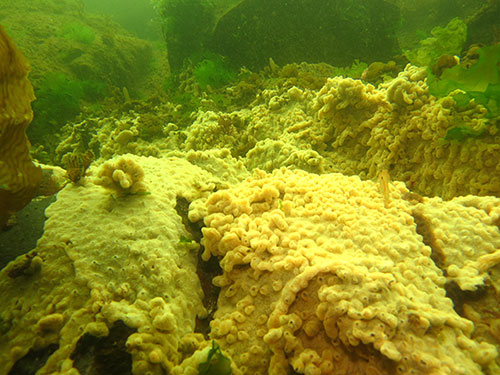
With limited examples of eradication protocols for in-water management of marine invasive species to guide him, Dr. Ian Davidson, an ecologist at SERC, took lessons from aquarium-scale experiments of the effects of various treatments on D. vexillum to conceive of a study plan for Whiting Harbor. In 2011, Davidson along with SERC colleagues and a local volunteer, conducted trials whereby they immersed small colonies of D. vexillum in six different treatments for varying intervals (McCann, et al. 2013). The results of their experiments provided insight for studying the use of biocide agents on a larger scale.
In our case, Davidson devised a study plan to enclose populations of D. vexillum within containment domes (tents) and then introduce agents to cause mortality to the tunicates. The idea being, if we can enclose the invasive tunicate in a dome such that we can keep the biocide agents targeted on the tunicates and keep the biocides from dispersing into the sea, we might be able to reach high enough concentrations over a long enough time period to cause mortality to the invasive tunicates. The objective is to create a similar system as in the smaller-scale study but on a larger-scale and in the ocean. It is a good plan; yet Dr. Davidson acknowledges that more than tunicates will be exposed to the treatments.
This May, the 105-foot ADF&G research vessel Kestrel, along with her captain, engineer and cook, were host to a large team of divers and biologists who converged on Whiting Harbor with the intent to put Dr. Davidson’s plan to work. The dive team consisted of five Division of Commercial Fisheries divers, including Sitka’s area management biologist Dave Gordon, one Division of Habitat diver, and three divers from SERC, Dr. Davidson among them. Biologists from the Bureau of Land Management (BLM) and the Division of Sport Fish, including myself, comprised the top-side team- offering support and collecting salinity and water quality data from inside the domes. Our objectives were to deploy domes, administer biocide agents into the domes, wait several hours and then break down the tents. We had multiple ADF&G skiffs outfitted for diving, the sun was shining, and the teams were excited to set to work.
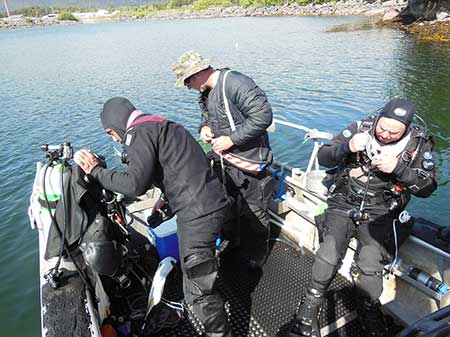
The divers deployed the domes according to protocol: situate the dome on the sea floor over the D.vexillum, place a chain enclosed in hose at the seam between the dome and the skirt, place bags of gravel on the skirt to reduce gaps between the tent and seafloor, unzip the domes to add the salt, chlorine, and lime as biocide agents, zip up the domes and allow the treatments to work. During the next four hours while the biocides were being taken up by the filter feeding D. vexillum, Tim Sundlov from BLM, began taking salinity measurements at the dome that had been treated with salt. The aim was to raise the salinity above ambient seawater, roughly 30 ppt. in Whiting Harbor, and have the water in the dome at a toxic level around 60 ppt. for as close as possible to the duration of the treatment period. Meanwhile, I was collecting water quality measurements at the chlorine dome. Here, our target was to have a spike so that the water in the dome would reach a chlorine concentration of approximately 200 mg/l almost immediately after the biocide was introduced. We anticipated the chlorine concentration would slowly degrade as it was oxidized by organic material over the four hour window and then we would see it crash to zero toward the end of the treatment interval.
Because we were intending to use these products as biocides to cause mortality to the invasive tunicate we were required to have approval from the Department of Environmental Conservation among other regulatory agencies. The biocide agents used are readily available products. Salt, in addition to being essential for animal life, has many other uses including seasoning and preserving food, softening hard water, and numerous industrial uses. Like salt, chlorine has many uses in manufacturing, many may recognize it as a disinfectant and a means to keep pools and hot tubs free of bacteria. Lime is a calcium-based powder used in the making of cement; it was used by researchers in New Zealand in their efforts to eradicate D. vexillum. All of the biocides were used in granular or powdered form. The chlorine and lime were mixed with seawater before being introduced into the domes by the divers.
It is fortunate that this first sunny field trip to Sitka was planned as a “proof of concept” trip. As any field biologist can tell you, things don’t always go as planned and this may be especially true when working underwater. During the trip, a number of domes were set and treated with salt, chlorine and lime. In some instances the treatments worked according to plan: dome went up without a hitch, salinity and chlorine concentrations hit the targets and could be sustained for roughly the duration of the trial and then they dropped in time for the dome to be broken down. Yet, other times the salinity rose and then quickly plunged back to ambient or the chlorine didn’t reach a concentration above 80 mg/l throughout the trial. We were challenged by anomalies. During that week in late May and early June the team fine-tuned their protocols and investigated various permutations in an attempt to get the treatments to hit concentration targets for a long enough window of time to affect the vitality of the D. vexillum within the domes. We had to get things right because we would be back in July to run a replicated experiment.
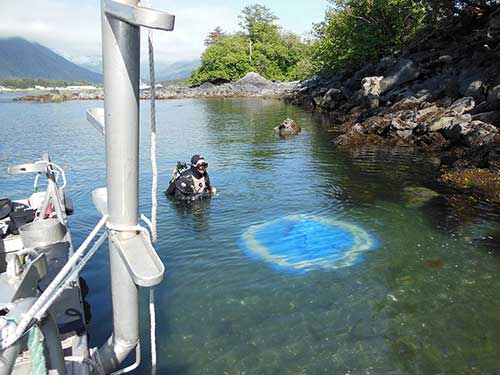
By the time July rolled around, Dr. Davidson and his SERC colleagues had designed new equipment to be used in the salt domes, and tweaked some of the treatment protocols. When we again met the Kestrel and crew in Whiting Harbor, this time the sun was shrouded in dark grey clouds, the winds had kicked up and it was pouring rain. We sat in the cozy galley and Dr. Davidson shared the game plan. Each day of the trip two blocks would be completed. Each block would have four domes deployed. A different treatment would go into each of three of the domes, one getting salt, one chlorine, and one lime. The fourth dome would act as a control and therefore would receive no treatment. Ian stressed the importance of ensuring that when each dome was deployed by the divers it was secured to the seabed with a good seal because if there were gaps we would have difficulty achieving the targeted concentrations of the biocides. Although some of the players had changed and the weather was less inviting than in May, “the band was back together” and they were ready to rock.
The skiffs were loaded with domes, the biocides-salt, chlorine and lime, and the equipment necessary for measuring water quality. Tim would take the salinity measurements of the salt treatments and I would again measure the water quality within the chlorine treated domes. The SERC team comprised of Dr. Davidson and Michelle Marraffini, they would be taking pictures of the blocks before and after the treatments occurred in order to measure changes in the D. vexillum after exposure to the biocides. Along with divers and skiff tenders, Tim and I loaded into our skiffs and then Gary, the engineer, lowered us down from the deck of the Kestrel to the waters of Whiting Harbor. The salt skiff was riding low in the stern, heavy with salt donated by the City and Borough of Sitka.
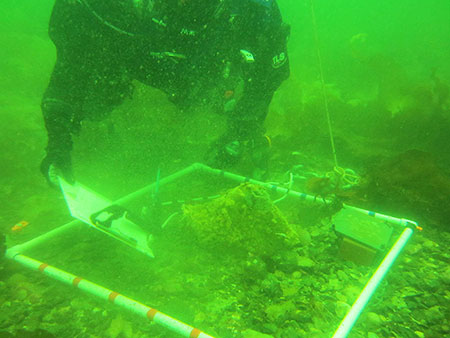
Each day we went through the same drill. Domes were deployed and secured, treatments administered, water quality measurements taken, domes removed. The sun came out after a couple of days. Each day two blocks were finished. By the end of the field trip we had completed 12 blocks in total and gathered a good amount of data. The team felt satisfied in their accomplishments. Despite the improvements in equipment and protocol, and even though the protocols were followed to a tee, we still saw some variances in our data. Still there were treatments in which the salinity didn’t reach 60 ppt. or the chlorine screamed up to 200 mg/l only to plummet and hover below 100 mg/l for the remainder of the trial.
To date, the data collected during our July trip has not been fully analyzed so I can’t tell you whether salt, lime or chlorine is a better agent for causing mortality to D.vexillum. However, several weeks after our July trip there was visual evidence that some of the biocide treatments were effective at causing mortality to the treated D. vexillum.
As the weather turns cold and stormy, we won’t be pitching any tents on the seafloor in the near future. For now, data needs be reviewed and reports will be written. But we are planning to head back to Sitka in the late winter or early spring to see how the D. vexillum is doing several months after exposure to salt, chlorine and lime. I don’t like to put the cart before the horse, but if the results of the experiment indicate that the domed treatments were effective, you might see a different kind of tent in Whiting Harbor in the future.
Citation
McCann, L.D., et al. Promoting invasive species control and eradication in the sea: Options for the managing tunicate invader Didemnum vexillum in Sitka, Alaska. Mar. Pollut. Bull. 2013.
Tammy Davis, is the Invasive Species Program Coordinator with Division of Sport Fish. In her free time Tammy enjoys poking around in the intertidal, hiking in the woods of SEAK, and dreams of being a research diver.
Subscribe to be notified about new issues
Receive a monthly notice about new issues and articles.
